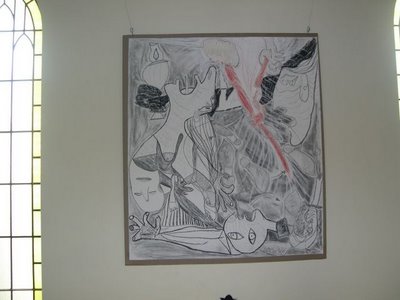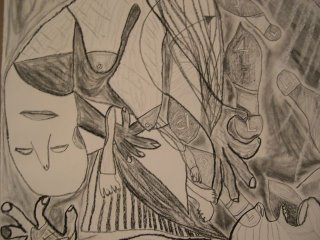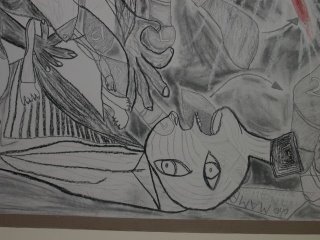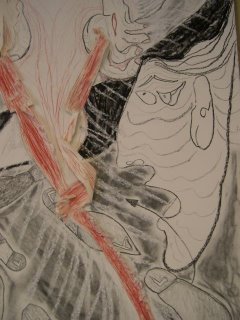This is an essay I wrote about a charcoal drawing I did for my church during the lenton season. There were 8 pieces put up in the sanctuary during lent. I have been part of other art projects for my church and they always come at a very profound time where God speaks to me through the creation of the art, I think perhaps more than those who might see it.
Lent is a time of reflection, evaluating, and contemplating what Jesus has done for me and what I can do for him. Also, the theme “Thy Kingdom Come,” to me, is a cry of all Christians for God to have mercy on this world. It is a call “to action” in a way. In the Lord’s Prayer Jesus is ask ing for something better than we have in this imperfect world. I looked up the word “Lent” to see what train of thought that would bring. I was surprised at how many service-oriented words it brought me to, and at how the word mercy kept being brought forward. What mercy does God daily bring us, and how should I practice mercy in my life? What does all this mean?
ing for something better than we have in this imperfect world. I looked up the word “Lent” to see what train of thought that would bring. I was surprised at how many service-oriented words it brought me to, and at how the word mercy kept being brought forward. What mercy does God daily bring us, and how should I practice mercy in my life? What does all this mean?
When Abbie and I began talking about the Lenten project this year, she mentioned that she saw a vision of hard-hitting art pieces that made people think: about people with AIDS (not just in Africa, but all around us); about the high instance of divorce and the havoc it produces in the live s of so many families; about how Christians need to reach out with the love of Jesus to the homosexual community; about how the body of Christ needs to love all people as part of the kingdom. My thoughts turned to local landmarks—something I could use to bring home the idea that God’s kingdom, the place where we need so desperately to serve, is all around us, on earth as it is in heaven. What landmark says
s of so many families; about how Christians need to reach out with the love of Jesus to the homosexual community; about how the body of Christ needs to love all people as part of the kingdom. My thoughts turned to local landmarks—something I could use to bring home the idea that God’s kingdom, the place where we need so desperately to serve, is all around us, on earth as it is in heaven. What landmark says
I thought about the first sermon in Dan’s series on the hands of God—about how Jesus reached out to the woman caught in adultery. I thought about portraying a modern Jesus in a biker jacket with his back to the viewer, but facing the adulterous woman. She would be like anyone we see every day on the streets of
I pinned all the photos on my living room wall, ready to start work. I did some sketches, but nothing was working out. It wasn’t right and I didn’t have the skill to draw what I wanted to portray. So I prayed a lot, staring at my blank piece of paper and playing music that always inspires me. I went back to square one, looking up scripture about mercy, kingdom, and hands. I searched the Internet for pictures matching those keywords. I also looked up the opposites to those themes—dark and painful images —wondering how to bridge the gap. Swords and ripping started appearing to me in forms of the cross along with the dance steps, but it still didn’t seem quite right.
During this time, I also received news that my older brother had been diagnosed with stage 4 stomach cancer. Unless God’s mercy intervenes soon, he has a limited time to live. It was if a bomb was blowing away my safe environment. As I was looking at all of this, Picasso’s
On
By May 1, news of the massacre at
After appearing in a
With pictures of  d’s mercy to rain down. The dance of life goes on, with all kinds of atrocities happening daily. We do learn to “mambo” around some of the worst things happening. However, the hands at the top belong to Jesus, whose shed blood rips through our lives with a blinding, healing light. Eternal life sheds a different light on how we spend our lives. One day Jesus will rip down the final curtain between this life and His kingdom. God takes what seems black and white and paints it
d’s mercy to rain down. The dance of life goes on, with all kinds of atrocities happening daily. We do learn to “mambo” around some of the worst things happening. However, the hands at the top belong to Jesus, whose shed blood rips through our lives with a blinding, healing light. Eternal life sheds a different light on how we spend our lives. One day Jesus will rip down the final curtain between this life and His kingdom. God takes what seems black and white and paints it  with his color. His bleeding hands, and the blood he shed for us, heal us no matter what bomb rips through our lives.
with his color. His bleeding hands, and the blood he shed for us, heal us no matter what bomb rips through our lives.
Papa Father,
We ask for your mercy to pour down on our lives. Heal us, we pray. Thy kingdom come, thy will be done, on earth as it is in Heaven.
In Jesus’ name, Amen.